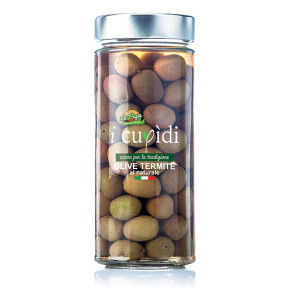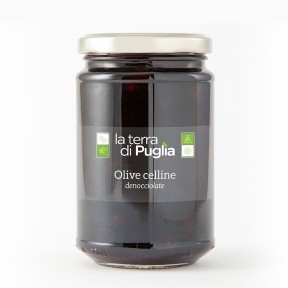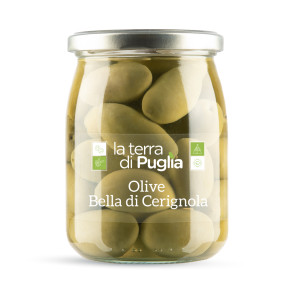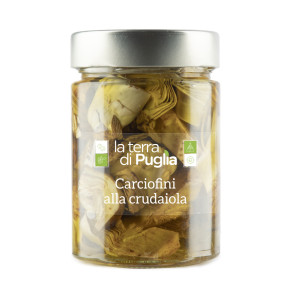Celline olives with myrtle: the Apulian olives that smell of the Mediterranean
Delicious, small, black as ink, doughy and fleshy to the right degree, Celline olives are ready to triumph on your table. It is the flavor of Puglia that we like, the one that reminds us of walks by the sea, where the Mediterranean scrub gives the landscape a pleasantly relaxing atmosphere, releasing a unique symphony of scents and fragrances into the air. These La Terra di Puglia branded olives are designed to accompany you to the seaside with us. Olives, myrtle and the desire to dream. What else do we need?
They are the typical olives of Salento. As with Leccine olives, these are harvested in November and left to lose their bitterness and ripen for six months in water and salt. They are finally potted in natural water and salt. Their typical use is as a condiment or enrichment for cooked vegetables, in particular "cicorine" and "paparine", i.e. wild vegetables that grow spontaneously throughout the province of Lecce and beyond. Alone. Wild vegetables are usually blanched, dipped in cold water and then sautéed with chilli pepper, spring onion and olives, with a sprinkling of cheese to finish everything. In any case, you can use these olives as you see fit, also to give life to a chicken Cacciatore or other recipe.
Again, try preparing a pasta with black olives or a sauce with black olives: your guests will go crazy for it!
Celline black olives: some useful information
They are the typical black olives of our area. They are harvested in November once veraison is complete. The farmers bring them to our farm where they are washed, divided by size, debitterized according to the ancient debitterization method which involves remaining in water and salt for 6 months. They are then selected again by hand one by one, and put into jars in water and natural salt.
Frequently asked questions about olives
Can those with high cholesterol eat olives?
Those with high cholesterol can eat olives in moderation, as they contain beneficial monounsaturated fats that can help maintain healthy cholesterol levels. However, it is important to avoid overly salted olives.
What olives are used for oil?
The olives used for oil include varieties such as Frantoio, Leccino, Coratina and Moraiolo, which are particularly appreciated for their high oil yield and the quality of the final product.
What type of olives are there in Puglia?
The types of olives found in Puglia include varieties such as Coratina, Ogliarola, Cellina di Nardò and Cima di Mola, all known for their excellent quality and their use both for oil and for direct consumption .
What are large olives called?
Large olives are often called "Bella di Cerignola" olives, a variety famous for its considerable size and delicate taste.
What are Salento olives called?
Salento olives include varieties such as Cellina di Nardò and Ogliarola Salentina, both typical of the Salento area in Puglia.
What are giant olives called?
The giant olives are known as "Bella di Cerignola olives", appreciated for their size and sweet flavor.
How are olives classified?
Olives are classified based on various criteria, including size (caliber), variety, color (green, black, red), and use (table or oil).
What are olive stones called?
Olive stones are called "endocarps" or simply "stones".
How to store Celline olives?
To preserve Celline olives, you can use methods such as brine, where the olives are immersed in a solution of water and salt, or preservation in oil, after having been desalted and flavored with spices to taste.


















